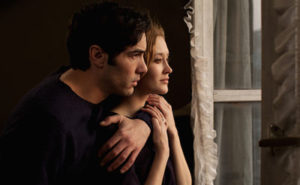STUDIO: Under the Milky Way | DIRECTOR: Kiyoshi Kurosawa | CAST: Tahar Rahim, Constance Rousseau, Olivier Gourmet, Mathieu Amalric, Malik Zidi
RELEASE DATE: 11/7/17
BONUSES: none
SPECS: NR | 131 min. | Foreign language drama | 2.35:1 widescreen | French with English subtitles
An intriguing new step in the career of one of the most talented filmmakers working today, Daguerrotype is the French-language debut of brilliant genre specialist Kiyoshi Kurosawa (Penance). The 2016 film is a French-Belgian-Japanese production, and it moves Kurosawa (no relation to Akira) into the world of Clouzot, Chabrol and other great French specialists in eerie suspense.
Kurosawa is a master at conveying the creepiness of a situation without going for overt shocks or horror. No matter what genre he’s worked in over the past 35 years, his films have been character studies first and foremost. Daguerrotype finds him working for the first time in a culture other than Japan and drawing on his evident love for French cinema as he sketches a tale that is predictable yet still contains its share of moving moments.
The plot is a classic scenario, in which a young man (Tahar Rahim, A Prophet) goes to work for a photographer (Olivier Gourmet, Mesrine: Public Enemy #1) who has quit the fashion world to exclusively produce daguerrotypes. The photographer is haunted by his late wife and uses his demure daughter (Constance Rousseau) as his primary model. The young man falls in love with the daughter and tries to help her escape her gloomy family mansion.
The environment inhabited by the characters is a Gallic version of the living spaces seen in Kurosawa’s previous films — Japanese apartments and homes that seem almost hermetically sealed off from the outside world. Here the young man at first exists in the real world, but he is quickly drawn into the photographer’s universe and, as the film moves on, even his own apartment becomes a “satellite” for the spell cast by the mansion.
The performances are all top notch, especially Rahim and Gourmet, who exhibit two different levels of “haunted” behavior. Their characters are both sympathetic but also are involved in one action that makes them seem to be casually sadistic – the subjects of the daguerrotypes must stand absolutely still for more than an hour, so the procedure includes a “brace” apparatus into which the subjects (nearly always women) must be locked.
The aspect of the film that will no doubt divide viewers is its screenplay. Kurosawa, whose script was adapted by Catherine Paillé and Eléonore Mahmoudian, surprises the viewer with a few unexpected twists, but the biggest and most important one is telegraphed in a discussion that takes place two-thirds into the film about whether or not what is occurring is real. In this regard, Kurosawa opts for a subtler form of the famous Vertigo reveal, in which the viewer is let on to the true outcome well before the finish of the picture.
It’s a measure of the excellence of the lead performances and Kurosawa’s skill at creating a tense (yet visually gorgeous) atmosphere that we still follow the characters with interest. Rahim is in fact so good that we feel for his character, even though we’re certain in advance what’s happening to him.
Kurosawa has already made another Japanese feature (and a TV miniseries!) since Daguerrotype, but the film shows he can transplant his skills internationally. Hopefully, though, he’ll stay away from making American major studio remakes of his moving, low-key pictures.
The film debuted on VOD on platforms including iTunes, Sony, Google Play, Amazon, Microsoft, Vudu, Comcast, Charter, Cox, Vimeo, and various other cable operators.

Leave a Reply